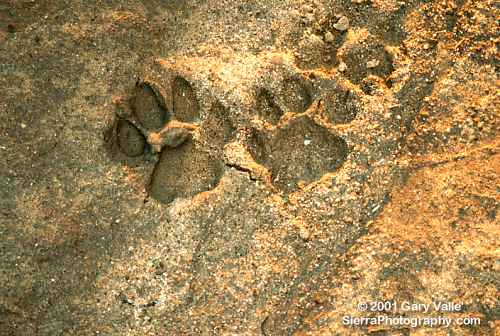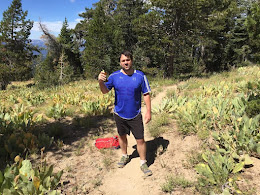
Somehow I managed not to drive the 8 miles out of my way to visit this sacred site in the South Dakota prairie.

I agree that mountain lions are beautiful animals - you'd have to be a fool not to see that the fearful symmetry of the great cats sets them at the pinnacle of predator evolution at this point in Earth's history. Their unwavering focus on predation extends from their nervous system and musculature straight down to their hemoglobin, specially engineered to allow quick-release bursts of oxygen for explosive speed and power (and in the kind of biochemical arms race we often see in evolution, ungulates have developed the same trick). But the cliches of savage nature's grace won't reassure you very much when you're going for a little walk with your four year old and you see one. It's odd to think that, like Africa, we still have enough powerful land predators to pose a threat to lone humans, and mountain lions are definitely around. I have seen two in a four year period, the first within 32 miles of the San Francisco city limits, the other within five miles. There have since been confirmed sightings even closer to the city than that, and five weeks ago I saw a classic track in mud on a trail in East Bay public watershed land within less than two miles of the Oakland city limits (not our photo - from sierraphotography.com):

Current estimates of the California population run from four to six thousand; presumably the density is similar throughout the West. If you spend any time in the great outdoors in this half of the country, even if you've never seen them, they've seen you. Of course, they typically would rather eat deer, but it's more than a little disturbing that the relatively small number of interactions is a result of their choice, not ours.
Unfortunately their decision process seems to be changing. Interactions are unquestionably on the upswing. For well over two centuries North America's mountain lions were on the run, hunted as dangerous vermin with the new weapons brought by European settlers on the East Coast; my home state of Pennsylvania is a microcosm in this regard. Still today mostly covered with temperate forests and tasty deer, Pennsylvania was apparently overrun with the things (hence Penn State's mascot) until pioneers like Daniel Boone began seriously hunting them out in the mid eighteenth century. Ironically enough, the last known kill in PA was in Boone's home county of Berks in 1874.
(As it turns out, mountain lions were already exterminated from North America once, by the first Native Americans across the land bridge, then recolonized the continent from South America. That is to say, the lions we now have haven't even been here as long as Native Americans. For more on the soap opera of mountain lion biohistory check out this seriously cool blog post.)
Today, like other East Coast residents, most Pennsylvanians are shocked to learn that there are even coyotes anywhere in their state, let alone that 150-lb. predators were once running around. It shouldn't be such a shock; they still have plenty of Appalachians and plenty of bears.
One of the main reasons that we twenty-first century citizens like going out into the wilderness is because we're inspired and humbled by a world which is, in its untamed-ness, at once beautiful and indifferent to us. You're reminded that the world exists independent of human inanity. But this experience is best appreciated by people who endure danger and physical discomfort only by choice, to inject a thrill into an otherwise very safe and even life (like the ones modern Americans have). When I'm out on those trails, it's to have fun. When Daniel Boone went out the door to hunt, he was protecting homesteads and earning a living. Even a twenty-first century trail addict like me gets spooked sometimes, and I have to admit that I enjoy running when I visit Pennsylvania because I can banish all thought of two yellow eyes coolly tracking me from twenty yards back in the brush. (Yes, I know the odds of getting hit by a car at a road crossing are worse, but it's psychology. Cars don't have sharp teeth. The same argument applies to tides vs. great whites in the channel between Alcatraz and San Francisco, and let's see you go swimming out there and not worry about them.)
The East Coast of North America does in fact still have mountain lions - in the Everglades, and in Quebec and New Brunswick. Of course the next question is, if they live in Quebec and the Maritime Provinces, why wouldn't they also be in Upstate New York? Passport problems? In fact in several eastern states - Pennsylvania, New York, New Jersey, West Virginia, and Kentucky - there have been a slew of mountain lion sightings in the last decade. That said, people are excitable, and until you see a photo or an expert can inspect wounds from an alleged attack, you're better off believing the fish & game authorities.
Unfortunately fish & game authorities in some places have denied reality even where there was medical or photographic evidence. In Pennsylvania there is no such evidence, but the reports were enough to get the US Fish and Wildlife Service to open an official inquiry. This is more than can be said for the authorities in any number of states further west, where it seems only embarrassingly concrete evidence will force the local agencies to admit the presence of mountain lions. The Black Hills of South Dakota are openly acknowledged as mountain lion territory. Think that they won't re-cross the plains? Check out this camera-trap photo taken near Duluth, Minnesota in 2007. Since 2001 there have been attacks on humans in South Dakota, Oklahoma, Arkansas, and Kansas. Lions have been killed (by guns and cars) in Iowa, and been seen repeatedly (and even attacked horses) in Michigan (take your pick on Youtube). And of course there was the "CNN" mountain lion, the one in suburban Chicago, which was related to the ones in the Black Hills. That lion crossed more than 900 miles. The confirmed lion population in Quebec is about 900 miles from Washington D.C. That horse attack in Michigan happened about 400 miles from central Pennsylvania.
The problem is not so much that the lions are recolonizing their old range, but rather that they're doing it in a place where citizens and authorities are in denial that they exist. (See this article by a former Fish and Game official in Arkansas.) What's more, in Daniel Boone's day, lions knew that when they saw humans, they either got shot at with an arrow, or they got shot at with a gun. Either way, they knew we were bad news. Today, their attitude is changing. When they do see humans, for the most part we're not hunting, and we really don't pose a threat. This is especially the case at urban-wildland interfaces - classic cases being Boulder, Los Angeles and Phoenix - where the lions are accustomed to the people who live there, but where the people who live there might not be aware of the lions.
I'm posting this not as an exhortation to charge into the wilderness with guns blazing, but as a call to awareness to avoid exactly that. A confirmed attack on a human in an area that didn't think it had mountain lions is one sure way to create a cougar lynch mob. Here in the Western states, we may not always agree on exactly how to use resources (especially water), but we're fortunate enough to have public lands management that's typically transparent and rational, and where there are mountain lions, there are signs saying so. In the Midwest, the mountain lion re-colonization is coupled with authorities who for whatever reason refuse to acknowledge the evidence, until there's a tragedy - and there already have been some.
I'm no wildlife expert, just a runner obsessed with mountain lions and wanting to make sure people know that there is another apex predator in North America besides us. If we all know they're there, then both species are less likely to get in trouble with the other, and less likely to react with a mob mentality that endangers wildlife when there's an encounter.
So what's the solution, besides awareness? I'm really not sure. The following story suggests one method: once I was near the Idaho-Oregon line, about to run down to the bottom of Hells Canyon. First I scrambled up to the fire look-out at the summit and chatted with the look-out guy. When I told him about my planned run, he asked "What are you carrying?" I said "Well, water, some Power Gel -" "No," he cut me off. "What are you carrying?" And then patted the 9mm on his belt that I hadn't noticed. He went on to tell me that several mornings before, when he got up at dawn, there was a mountain lion watching him through the glass walls from about 25 feet outside the look-out window, and he'd worn the weapon since then. For someone whose profession keeps him or her in the equivalent of mountain lion-Manhattan (and human-Idaho) for months on end, that's a legitimate option. For city-boy and -girl hikers, probably not so much.
Here's another one: in Denali National Park, when there is a grizzly-human interaction (even if one gets into your food when you're away from your tent), the National Park Service shoots the bears with rubber bullets, scares them with noises broadcast from helicopters, and generally makes the bear(s) in question associate human interactions with unpleasantness. The difference is that grizzlies are much more frequently seen in the open than mountain lions, so that deterrence programs can be more "personalized" to them. Maybe parks and open space authorities could put out deer meat once or twice a year that has some sort of human scent on it, but is loaded with some kind of emetic - not to kill the lion, just to make it sick. Lions that show interest in humans often seem to be young ones that don't know any better, and indeed it's been shown from spoor analysis that they do have a learning curve - for example, you're much less likely to find porcupine quills in the spoor of a lion older than two, because they finally get smart and realize porcupines are no fun to eat. That's why the young ones are good candidates for amygdalic programming this way.
In the meantime, remember: with all the trail users around the Bay Area, and all the lions that must surely have seen them, that there has never, ever been an attack. There have been lions that made the fatal mistake of meandering into cities (like Palo Alto), fatal because tranquilizer darts are only instantaneous in movies, and if the lion won't leave town on its own, you don't have much choice. It's worth pointing out that even during the in-town encounters they didn't bother anybody. And even though the chances of being attacked are remote, they are still not zero. Keep kids and small dogs near you in mountain lion areas; if you see one, look big, don't run, and fight back if attacked. And make sure you tell people as far east as Michigan that yes, they definitely do have mountain lions.
 (Image credit to Alex Gregory and the New Yorker)
(Image credit to Alex Gregory and the New Yorker)